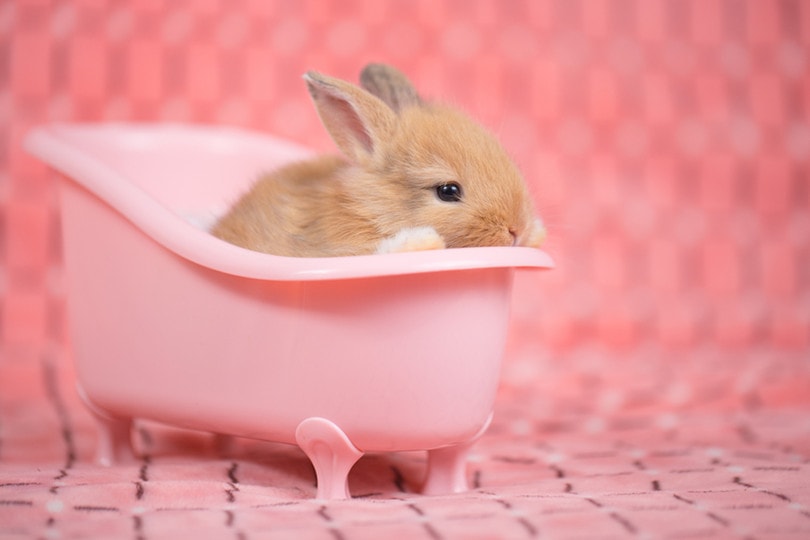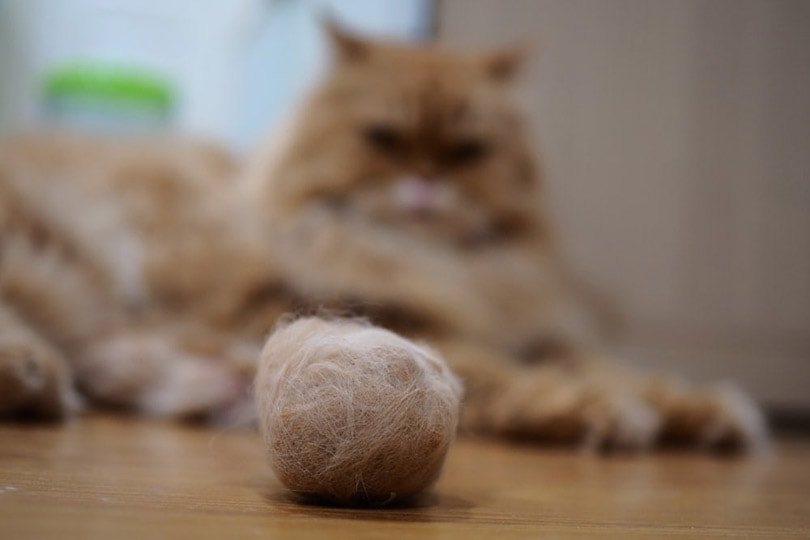VET APPROVED

The information is current and up-to-date in accordance with the latest veterinarian research.
Learn more »If you’re new to keeping rabbits as house pets, you may be wondering: How can I help to keep my bunny clean? Thankfully, a rabbit’s general cleanliness is a very attractive part of keeping one as a pet: They do a great job of keeping themselves clean and rarely need to be given baths. Rabbits are not big fans of water, and their coats can take a very long time to dry completely.
When your rabbit does get dirty, though the result of health problems preventing them from cleaning themselves, or maybe just a day of too much fun splashing around in mud puddles, it’s important to clean them in the least invasive way possible. Bathing your rabbit in these situations will help them avoid common illnesses and infections resulting from improper hygiene.
This guide will take you step-by-step through the process of choosing a method of cleaning and give helpful tutorials for each type of bath. Let’s get started!

Does Your Rabbit Need a Bath?
So, when is it really time to give your rabbit a bath? Since most rabbits do a fantastic job of keeping themselves clean, dry, and fresh smelling, the best bathing strategy for any rabbit owner is to wash them as little as necessary. Because rabbits are easily shocked by unfamiliar settings, the less you must do to clean them, the better!

Some situations where it may be necessary to bathe your rabbit include:
- Overweight rabbits may find it hard to clean their rear ends.
- When dental problems or arthritis may prevent them from cleaning their fur.
- If mud has been allowed to cake on or dry after a day of playing outdoors.
- In cases of flea infestation.
If it so happens that your rabbit does need a bath, use the following techniques:
The 4 Safe Ways to Bathe Your Rabbit
1. Dry Bath
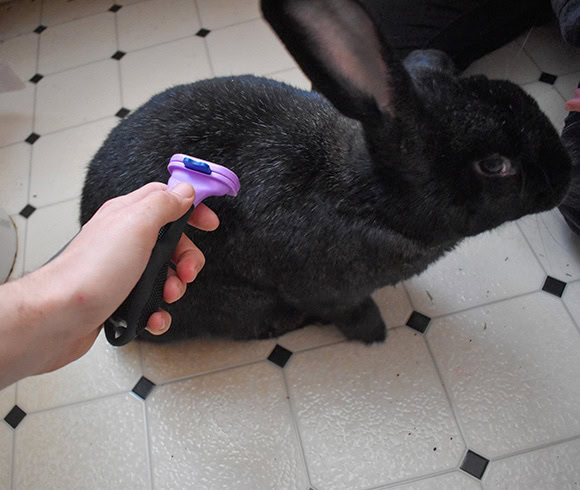
When your rabbit is only mildly dirty—perhaps with some excess dust or hay on their coat—a dry bath is the perfect solution. Something as simple as giving them a thorough brushing is a reliable method to clean your bunny on a regular basis. Be sure to get a comb or brush that is specifically made for rabbits, as they have finer teeth than most brushes made for dogs or cats.
If your rabbit has a dirty wet spot, the dry bath is a perfect solution. Just sprinkle a little bit of cornstarch on the wet area, then use your rabbit comb to brush it out. Even if they are nearly covered in mud, it is a better idea to use a dry bath section by section than to get them wet, as this poses a risk of sending them into shock.
2. Spot Cleaning
At times when your rabbit is particularly dirty or smelly, it may be necessary to use a little bit of water to help groom them. Spot cleaning should be your next bathing method: Dip a towel into warm water, and lightly dab it onto your rabbit’s dirty areas.
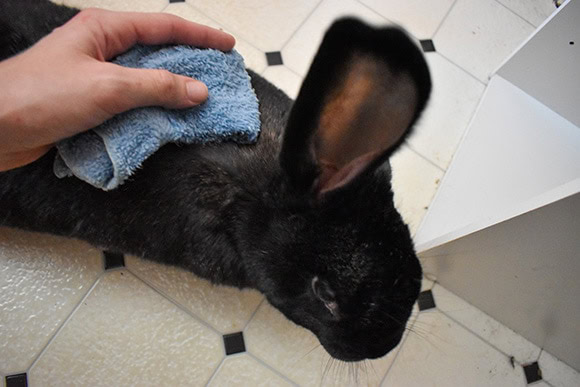
Rabbit skin is very delicate, and their fur takes a very long time to dry completely—so try to avoid soaking all the way through to the skin. Instead, keep the dampness as close to the surface of their coat as possible, and use a blow dryer to finish helping them dry out.
3. Sink or Tub Bath
If the previous two methods have not been effective in getting your rabbit clean, it is time to move on to the last method of bathing: the sink bath. Whereas this sort of bath may be the norm for messy dogs or cats, it should be your last resort to help clean your rabbit.
Why is this? Rabbits keep an average body temperature of 101 to 103 degrees Fahrenheit and can be easily affected by hypothermia if submerged in water. What’s more, being in even a small amount of water can be anxiety-inducing for many rabbits, leading them to thrash and possibly injure themselves.
To make a sink or tub bath as safe as possible:
- Fully wet a towel with warm water and lay it in the bottom of your sink or tub. This will give your rabbit traction and help keep it calm.
- Don’t run more than an inch of water, and make sure the water is just warm—not hot or cold.
- Only use shampoo that is specially made for rabbits and use only the directed amount.
- Avoid the rabbit’s head and ears unless absolutely necessary.
After its bath, first, towel-dry your rabbit as much as possible, and then blow-dry its coat to finish the drying process.
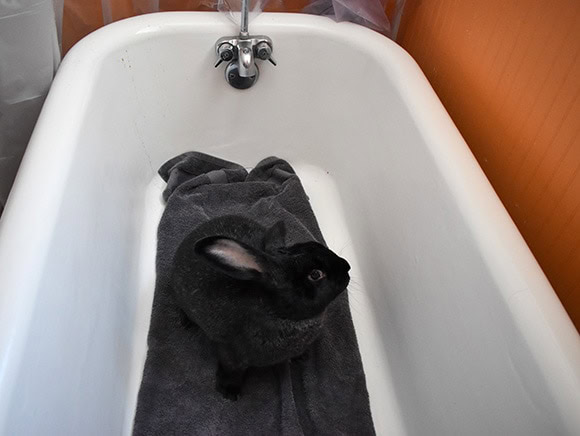
4. Blow Dry
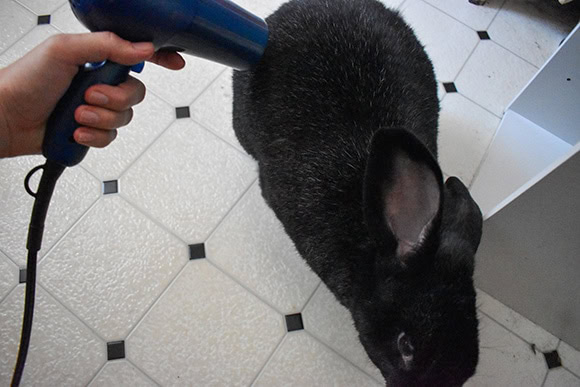
After any of these cleaning methods, it can be helpful to blow dry your rabbit to ensure that its coat is completely dry and free of debris. Be absolutely sure to use the lowest heat and airflow settings, and keep the blow dryer well away from your rabbit’s face. Work in short bursts, to prevent stressing your rabbit by overwarming it.
Conclusion
Rabbits make wonderful pets for so many reasons, not the least of which is how clean they keep themselves. If your rabbit needs a little bit of help for whatever reason, we hope this guide helps to show you exactly how to bathe a bunny in the most gentle and caring way possible.
However, always remember: If you’re in doubt about any health-related issue with your rabbit, call your vet to confirm what your next best step is!
- You may also be interested in: PetArmor Plus vs Frontline Plus: What’s the Difference? (Vet Answers)
Featured Image Credit: Roselynne, Shutterstock
